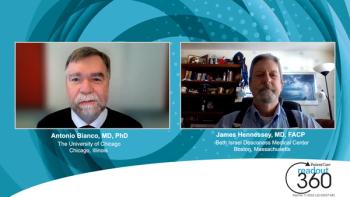
Graves’ Disease Refresher for Primary Care
What are the common presenting symptoms? How is Graves' best diagnosed? What are the 3 key treatments? Brush-up on the basics, here.
[[{"type":"media","view_mode":"media_crop","fid":"47883","attributes":{"alt":"","class":"media-image media-image-right","height":"354","id":"media_crop_3043592750980","media_crop_h":"0","media_crop_image_style":"-1","media_crop_instance":"5681","media_crop_rotate":"0","media_crop_scale_h":"0","media_crop_scale_w":"0","media_crop_w":"0","media_crop_x":"0","media_crop_y":"0","style":"float: right;","title":"©Sebastian Kaulitzky/Shutterstock.com","typeof":"foaf:Image","width":"267"}}]]Graves’ disease, the most common cause of hyperthyroidism,1 is an autoimmune disorder. Excess thyroid hormone is a consequence of autoantibody activity against thyroid stimulating hormone (TSH) receptors on thyroid follicular cells. The multisystem impact of TSH is responsible for the wide range of symptoms seen in Graves’ disease. Expression of TSH receptors in retro-orbital tissue in particular is responsible for the exophthalmos often see in patients with the disease.1
Graves’ may be suspected based on history and physical examination, diagnosed through laboratory and imaging studies, and treated with one of three therapeutic modalities. Recent data from Japanese clinical researchers may offer an alternative therapy for less severe cases of Graves’ and future treatments may rely on receptor-specific blockade.
The clinical spectrum
Patients with Graves’ disease may present initially to their primary care physician. Typical complaints include: palpitations, tremulousness, weight loss, and heat intolerance.1 Twenty per cent of patients may complain of hyperdefecation.1 Older patients more often have atrial fibrillation and weight loss.1 Twenty-five per cent of persons with Graves’ have extrathyroid manifestations-exophthalmos, dermopathy (pretibial skin thickening), or “achropachy,” a form of nail clubbing.1 Initial laboratory studies may detect leukopenia, hypercalcemia, and/or elevated bone alkaline phosphatase.1 The bone complications mediated by excess thyroid hormone are a consequence of increased osteoclastic activity and include osteoporosis.1
Although the symptoms above are classic manifestations of Graves’-induced hyperthyroidism, elderly patients may present with only “apathetic” features, eg, obtundation and coma, and with arrhythmias (atrial fibrillation) and heart failure.2
[[{"type":"media","view_mode":"media_crop","fid":"47882","attributes":{"alt":"","class":"media-image media-image-right","height":"187","id":"media_crop_7576856466265","media_crop_h":"0","media_crop_image_style":"-1","media_crop_instance":"5680","media_crop_rotate":"0","media_crop_scale_h":"0","media_crop_scale_w":"0","media_crop_w":"0","media_crop_x":"0","media_crop_y":"0","style":"margin: 10px; float: right;","title":"©Bork/Shutterstock.com ","typeof":"foaf:Image","width":"282"}}]]History, physical examination, and basic laboratory studies should be accompanied by the important diagnostic triad for hyperthyroidism: elevated thyroxine (T4) and tri-iodothyronine (T3), and undetectable or very low level of TSH.1 If there is still some doubt regarding the diagnosis of Graves’, three additional noninvasive tests may be added to confirm: TSH-receptor antibody level, radioactive iodine (RAI) uptake, or thyroid ultrasound with Doppler.1 If hyperthyroidism is caused by a toxic nodule, for example, there will be no antibodies, the uptake of RAI will not be smooth and homogenous, and the thyroid imaging/Doppler will not reflect an increase in blood flow to a diffusely enlarged gland.1
How is Graves’ treated?
Definitive treatment options for Graves’ are: antithyroid drugs (methimazole or propylthiouracil), RAI therapy, or surgery. In the US, nearly 60% of endocrinologists favor RAI, 40% antithyroid medications, and less than 1% surgery.1 Outside the US, antithyroid drugs are favored more frequently.1 Other agents-such as beta blockers-are used to treat symptoms of Graves’ disease.
Drug therapy may induce a remission in Graves’ hyperthyroidism in 40% to 50% of those treated for 12 to 18 months.1,3 Thyroid function testing is performed 2 to 6 weeks after treatment is initiated.1 The most common side effects associated with these agents are: agranulocytosis (almost always occurs within the first 90 days of treatment) rash, arthralgias, cholestatic (methimazole) or hepatocellular injury to the liver (propylthiouracil), and an ANCA-associated vasculitis.1
RAI therapy is a quick way to correct hyperthyroidism with Graves’, but induces permanent hypothyroidism in 80% of those treated and may aggravate Graves’ eye disease (a result more common in smokers).1 Corticosteroid prophylaxis is recommended prior to RAI in tobacco smokers and those with moderate to severe orbital disease (>3 mm proptosis or periorbital soft tissue inflammation).1
[[{"type":"media","view_mode":"media_crop","fid":"47884","attributes":{"alt":"","class":"media-image media-image-left","id":"media_crop_9931640225175","media_crop_h":"0","media_crop_image_style":"-1","media_crop_instance":"5682","media_crop_rotate":"0","media_crop_scale_h":"0","media_crop_scale_w":"0","media_crop_w":"0","media_crop_x":"0","media_crop_y":"0","style":"float: left; margin: 8px; height: 232px; width: 265px;","title":"©O2creationz/Shutterstock.com ","typeof":"foaf:Image"}}]]Surgery is not a preferred first-line treatment for Graves’ hyperthyroidism but can be effective for persons intolerant of medical therapy or those with very large goiters, compressive symptoms, additional suspicious nodules, or accompanying hyperparathyroidism. Surgery may also reflect patient preference.1
Hypothyroidism induced by both RAI and surgery requires lifelong oral thyroid replacement therapy.
Graves’ disease during pregnancy is therapeutically dissimilar. RAI therapy is contraindicated and propylthiouracil should be used only in the first trimester if necessary (methimazole causes birth defects in the first trimester).1
Other treatment options?
In a 2014 study in Japan, 30 patients with mild Graves’ disease were treated with potassium iodide (50-100 mg/day).1,4 Iodine-for reasons not completely explained-has a suppressive effect on thyroid hormone synthesis, called the Wolffe-Chaikoff effect. After one year of therapy, the individuals treated with potassium iodide did as well as patients receiving methimazole. Although potassium iodide may have a therapeutic role, it might be limited to milder forms of Graves’ disease only.
Research into future treatments includes development of small molecules that will behave as TSH receptor antagonists and block the connection between the antibodies and the TSH receptor.1,5
References:
1. Burch HB, Cooper DS. Management of Graves’ disease: a review. JAMA 2015; 315:2544-255.
2. Ghobrial MW, Ruby EB. Coma and thyroid storm in apathetic thyrotoxicosis. Southern Med J. 2002; 95:552-554.
3. Sundaresh V, Brito JP, Wang Z, et al. Comparative effectiveness of therapies for Graves’ hyperthyroidism: a systematic review and network meta-analysis. J Clin Endocrinol Metab. 2013; 98:3671-3677.
4. Uchida T, Goto H, Kasai T, et al.
5. Neumann S, Nir EA, Eliseeva E, et al. A selective TSH receptor antagonist inhibits stimulation of thyroid function in female mice. Endocrinology. 2014; 155:310-314.
Newsletter
Enhance your clinical practice with the Patient Care newsletter, offering the latest evidence-based guidelines, diagnostic insights, and treatment strategies for primary care physicians.


















































































































































































































































































